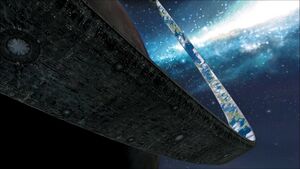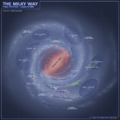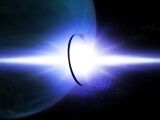Halo Array
From Halo: Daybreak
| This article is currently under construction. As the subject is under active development, information here may not yet be final. |
Halo is a name given to a set of ring-shaped superweapons and habitats forged by the Forerunners to stop the Flood parasite. In tandem, these "Fortress Worlds" comprise the Halo Array, a galactic network of seven rings designed to sterilize the entire Milky Way galaxy of sentient life, depriving the Flood of hosts and starving it to death. The Halo installations were constructed at the Ark or Installation 00, a megastructure located far above the galactic plane out of range of the superweapons' pulse. Following the firing of the rings, biological samples kept at the Ark were used to repopulate the species of the galaxy indexed by the Forerunners as part of the Conservation Measure.
The Covenant revered the Halos as the "Sacred Rings". According to the Covenant religion, based largely on oft-misinterpreted, fragmentary or corrupted Forerunner records, the Forerunners had embarked on a "Great Journey", propelling themselves into divinity and leaving behind material existence. By discovering and activating the rings, the Covenant believed they could follow in the Forerunners' footsteps and ascend into godhood.
Features[edit | edit source]
The Halos are full-fledged ringworlds, specifically a larger and more technologically sophisticated variant of the classical Bishop Ring concept. Each Halo installation is 10,049 kilometers in diameter, 318 kilometers wide and 22.3 kilometers thick. The inner surface of each Halo ring houses a self-sustaining ecosystem complete with artificial terrain, designed to both house and study numerous forms of life. Coupled with dedicated research laboratories, it was hoped that by studying the effects of the Flood in a controlled environment, a cure for the parasite may one day be found. These artificial ecosystems or refugia vary between the installations and even a single installation may encompass more than one distinct refugium. Installations 04 and 05 were largely dedicated to terrestrial-like life, and in many cases terrestrial-based life encountered elsewhere.
The Halos achieve gravity through a combination of centripetal force and gravitic plating that runs throughout the ring. While the strength of gravity can vary somewhat by refugium, the "standard" gravity observed on Installations 04 and 05 is slightly below and above 1g, respectively. While full equivalent spin gravity could be achieved by speeding up the rings' rotation, this would also give them a hectic day-night cycle of around 75 minutes. The ring's atmosphere is held in place by enormous walls lining the Halo's edges as well as the artificial gravitic field, preventing it from leaking into space.
Each Halo ring is overseen by a monitor, a robotic artificial intelligence custodian. Various subordinate constructs operate under the monitor, along with an expansive fleet of sentinel drones for repairs and defense.
Positioning[edit | edit source]
Transported into place from the Ark through the use of temporary slipspace portals, the Halo rings were anchored in Lagrange points between large gas/ice giants and their moons. Giant planets were chosen as a security measure; should a Halo fall under Flood control, it could in extremis be deorbited into the planet where it would be annihilated by the immense gravity. To this end, along with the need to perform periodic orbital adjustments, the Halos are equipped with sublight maneuvering engines, though they remain slow and cumbersome to move.
Systems considered remote to the Forerunners and any concurrent subject civilizations were deliberately chosen to avoid discovery by unwanted actors, especially the Flood. As such, all of the Halo rings' star systems are far out of the way of major centers of Forerunner civilization or commercial routes, though Soell system did house an older and long-abandoned gas refinery complex repurposed as a Flood research facility earlier in the Diluvial War. The installations are spaced at roughly even intervals within the galaxy in such a way that their 25,000 light-year-radius pulses would blanket the entire galaxy. The inner Galactic Core is an exception as no life can survive there and it cannot be navigated via slipspace; the furthest fringes of the galactic halo are also not covered. However, when fired in tandem, the rings' overlapping pulses amplify one another and allow each ring to cover a much larger region of space than the individual installations' 25,000 light-year radius.
Installations 04 and 05 were evidently placed in relative proximity to one another within the Orion Arm as the region is suspected to have been the most populated one in the galaxy by the Forerunners' time. The presence of more than one ring was to ensure that the spiral arm could still be sterilized even in the event one of the rings were to fail or be discovered by the Flood.
Installation 00 / The Ark[edit | edit source]
- Main article: Installation 00
Installation 01 / Beta Halo[edit | edit source]
Installation 02 / Epsilon Halo[edit | edit source]
- Main article: Halo Installation 02
Installation 03 / Eta Halo[edit | edit source]
Installation 04 / Alpha Halo[edit | edit source]
Installation 04, or Alpha Halo, orbited the gas giant Threshold in the Soell system, located within the Local Bubble in the Orion Arm. The first Halo ring to be discovered by both the UNSC and the Covenant, Alpha Halo was discovered near-simultaneously by the two parties in September 2552 as the Covenant Fleet of Particular Justice followed the UNSC Pillar of Autumn fleeing from the Fall of Reach. The Autumn jumped to the Soell system following coordinates decrypted by the AI Cortana from a Forerunner star chart found on Sigma Octanus IV, though unbeknownst to her, the UNSC or the Covenant, the coordinates did not actually point to the ring, but the gas mining complex at Threshold which predated the Halos by centuries.
An intense battle followed between the surviving crew and complement of the Pillar of Autumn and the Covenant of the Fleet of Particular Justice, seeing the release of the Flood stored on the ring. Alpha Halo was subsequently destroyed by Spartan-II John-117 on September 22, 2552 to prevent the spread of the Flood. The ring's monitor, 343 Guilty Spark, survived 04's destruction and subsequently made contact with a Covenant artifact recovery group on one of Threshold's gas refineries, seeking to warn them of the Flood samples stored there. The Covenant holy city, High Charity, arrived in the system a few days later along with its defense fleet and scoured through the shattered ring's debris field for intact relics and data. While numerous secondary relics were recovered, the most notable discovery was an intact wavespace beacon which enabled them to pinpoint the location of Installation 05. An artifact-retrieval fleet of the Ministry of Tranquility was left in the system while High Charity departed for Delta Halo. After the Covenant War, Installation 04's debris field was captured by a joint Schismatic-UNSC force. The Treaty of Arusha established the Alpha Halo debris field as one of the strategic Forerunner sites to be jointly held by the two groups. A base of operations, Keyes Station, was subsequently established in an outlying Forerunner facility on Threshold's moon of Vector as both a scientific base and for carrying out high-risk missions within the debris field while a joint fleet patrolled the system to prevent scavengers and hostile factions from breaking the quarantine around Threshold.
Installation 05 / Delta Halo[edit | edit source]
Orbiting the gas giant Substance in the Coelest system located between the Orion and the Sagittarius Arms, Installation 05 or Delta Halo was the second Halo to be discovered by the Covenant. Given its relative proximity to Installation 04, it may have acted as a backup for sterilizing the Orion Arm. Not long after the activation of the Halos, Delta Halo's containment systems failed, which allowed the Flood samples to escape, where they would capture its monitor 2401 Penitent Tangent and establish a Gravemind. This started a near-100,000 year struggle between the plague and the Sentinel caretakers.
After High Charity uncovered Delta Halo's location from one of Alpha Halo's autonomous wavespace transceivers, the Covenant made best speed to the facility. It played host to the Battle of Delta Halo and the opening battles of the Great Schism, where the Covenant almost succeeded in activating the installation, but were stopped by UNSC and Schismatic forces. The aborted firing put the entire Halo array into a standby status, which was only shut down during the Battle of the Ark. In the aftermath, it was carefully quarantined for Flood infection, and control of the Coelest system is now jointly held by the UNSC and the Concord of Reconciliation.
Installation 06 / Gamma Halo[edit | edit source]
Installation 07 / Zeta Halo[edit | edit source]
Installation 08 / Replacement Alpha Halo[edit | edit source]
When Alpha Halo was destroyed, it sent a signal to the Ark that caused it to immediately begin construction of a replacement. Designated as Installation 08, it was built as a copy of its predecessor, with much of the terraformed landscape being identical. During the Battle of the Ark, a small squad led by John-117 and Thel 'Vadam fought their way to its control center and fire the Halo. Its incomplete state saw it self-destruct, severely damaging the Ark and wiping out the Flood presence.
Production notes[edit | edit source]
In the Daybreak Continuum, the Halos' locations diverge from the ones shown in the galaxy map in Halo Warfleet. This is mostly for astrographic reasons. Having Installation 04 relatively close to Earth is required in order to depict UNSC slipspace travel times consistently, and as much is suggested by the pre-CE notion that the Soell system is the real-life star Iota Horologii. Installation 05 is also positioned for consistency reasons. Since Covenant ships can travel between the Local Region and Delta Halo in two-week jumps, the installation was placed as close as it could feasibly be so as to avoid trivializing galactic-scale slipspace travel. Daybreak's concept also places the Halos in a numeric order, which makes a definite sense. The other rings have not been definitively placed as they are not as of yet narratively relevant; the galaxy map below is a possible approximation. Something useful to note as well is the fact the Array facilities are not easy to find; the fact the Covenant scoured the galaxy for 3,400 years searching for them without finding a single one attests to this. No one is going to accidentally stumble upon a Halo and it will be decades if not centuries before a new one is brought into the narrative. This is also part of Daybreak's "Two Sticks and a Rock" philosophy, in which we seek to work with what we have as much as possible and only introducing major Forerunner installations as narrative game-changers to underline their sheer importance.
The Halo rings in Daybreak also lack many of the additional features introduced in the 343i era: namely, an independent slipspace capability, the ability to eject given pieces of terrain at will, effectively police a light-year of space around them, or maintain structural cohesion with large sections of the superstructure missing. Such features are omitted because if applied consistently, they would seemingly prevent large parts of the Halo narrative from ever happening, or simply do not make sense with the overarching concept of the Halos. Namely:
- The rings (and even individual ring segments) having an independent slipspace capability would be bizarre in light of the fact the Halos housed Flood specimens; should the Flood take over a slipspace-capable ring, it would essentially have a mobile fortress world and superweapon at its disposal.
- If the Halos' monitors could eject their rings' terrain at any given time, why would Guilty Spark not use this capability to rid the ring of the Flood outbreak or a certain pesky meddling Reclaimer and his AI companion? One also imagines this feature would have been useful for Penitent Tangent when the Flood began to take over Delta Halo.
- In the Conversations From the Universe booklet shipped with the limited edition of Halo 2, civilizations are mentioned as having landed on and freely explored Alpha Halo prior to the Covenant and the UNSC. If Guilty Spark had the ability and mandate to destroy any incoming ships at will, as established in the Halo: Combat Evolved Anniversary terminals, it is extremely questionable that he would have allowed this to happen. The terminals also never provide an answer for why Spark allowed the Covenant to land even if he allowed passage for the Reclaimers on the Autumn, especially given the obvious hostility between said Reclaimers and the Covenant.
- Finally, if the rings could be held structurally intact via energy fields even with large plate sections missing, as seen in Halo Escalation and Halo Infinite, why did Spark not apply this measure when (or preferably before) the Pillar of Autumn's reactors went critical, seeing as he was aboard the Autumn and had ample warning? In fact, why did he not eject the entire Autumn into space the moment he saw what the Master Chief was trying to do?
Overall, the addition of these features is unnecessary as they not only do not contribute anything to the story but also introduce more problems. Consequently, we have opted to leave them out in Daybreak. It is apparent that the Halos' capabilities are meant to be much more limited than shown in post-2009 canon, as is the monitors' toolset for dealing with problems that crop up on the rings.
As another divergence from 343i canon, Installation 03 is now known as Eta Halo by its Greek alphabetic designation rather than Gamma Halo, with the latter name being assigned to Installation 06 instead. This is to follow the naming established by the Halo 3 game files for the rings.









